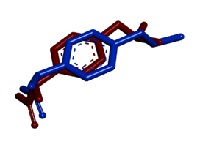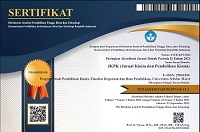
Molecular Docking Study of Active Compounds in White Radish (Raphanus sativus L.) on Cyclooxygenase-2 (COX-2) Receptor as an Anti-Inflammatory Agent
Abstract
Inflammation is a natural endogenous response to injury, infection, or external stimuli, and it plays a critical role in the pathogenesis of various diseases, including arthritis and osteoarthritis. Despite their effectiveness, the long-term use of nonsteroidal anti-inflammatory drugs (NSAIDs) often leads to several adverse effects, particularly gastrointestinal complications. Therefore, it is crucial to explore safer alternative therapies. This study aimed to evaluate the potential of bioactive compounds found in white radish (Raphanus sativus L.) as alternative anti-inflammatory agents using in silico molecular docking analysis against the cyclooxygenase-2 (COX-2) enzyme. Molecular docking simulations were performed using AutoDock Vina software, with the COX-2 structure obtained from the Protein Data Bank (PDB ID: 4PH9). The docking results indicated that glucoraphanin and squalene exhibited strong binding affinities with binding energies of –8.53 kcal/mol and –8.62 kcal/mol, respectively. Glucoraphanin was found to form hydrogen bonds with key active site residues similar to the interaction observed with ibuprofen, a standard NSAID. Meanwhile, squalene predominantly engaged in hydrophobic interactions with the enzyme. These findings suggest that glucoraphanin and squalene have the potential to act as effective COX-2 inhibitors and could serve as safer alternatives to conventional NSAIDs. However, further in vitro and in vivo studies are essential to validate their therapeutic potential and safety profiles.
Keywords
Full Text:
PDFReferences
[1] Emelda, N. Kusumawardani, R. D. Alfiana, D. Saputri, and Moch.Saiful Bachri, “Efek Anti-Inflamasi Pemberian Oral Dan Topikal Daun Sirih Merah Dan Minyak Kayu Manis,” Med. Sains J. Ilm. Kefarmasian, vol. 7, no. 3, pp. 595–608, 2022, doi: 10.37874/ms.v7i3.431.
[2] Emelda, R. D. Alfiana, N. Kusumawardani, Yolanda, and S. Widyarini, “The Episiotomy Effect of Topical Combination of Cinnamon Oil and Red Betel on Skin Wound Healing Mechanism,” Proc. 2nd Int. Conf. Contemp. Sci. Clin. Pharm. 2021 (ICCSCP 2021), vol. 40, no. Iccscp, pp. 144–151, 2022, doi: 10.2991/ahsr.k.211105.021.
[3] R. D. Alfiana, S. Mulyaningsih, E. Emelda, D. P. Paramita, A. R. Delia, and S. Salsabila, “The Effectiveness of Red Betel Leaf and Cinnamon Oil for Antibacterial and Anti-inflammatory in Perineal Tears: A Scoping Review,” Open Access Maced. J. Med. Sci., vol. 10, no. T8, pp. 102–107, 2022, doi: 10.3889/oamjms.2022.9497.
[4] F. W. D. Tai and M. E. McAlindon, “Non-steroidal anti-inflammatory drugs and the gastrointestinal tract,” Clin. Med. J. R. Coll. Physicians London, vol. 21, no. 2, pp. 131–134, 2021, doi: 10.7861/CLINMED.2021-0039.
[5] R. Sohail et al., “Effects of Non-steroidal Anti-inflammatory Drugs (NSAIDs) and Gastroprotective NSAIDs on the Gastrointestinal Tract: A Narrative Review,” Cureus, vol. 15, no. 4, pp. 1–14, 2023, doi: 10.7759/cureus.37080.
[6] N. K. Panchal and E. Prince Sabina, “Non-steroidal anti-inflammatory drugs (NSAIDs): A current insight into their molecular mechanism eliciting organ toxicities,” Food Chem. Toxicol., vol. 172, p. 113598, 2023, doi: 10.1016/j.fct.2022.113598.
[7] G. Bereda, “Biomedical and Biological Sciences : Peptic Ulcer Disease: Definition, Pathophysiology, and Treatment,” Biomed. Biol. Sci., vol. 1, no. 2, pp. 1–11, 2022.
[8] H. Khan et al., “Targeting NF-κB signaling pathway in cancer by dietary polyphenols,” Crit. Rev. Food Sci. Nutr., vol. 60, no. 16, pp. 2790–2800, 2020, doi: 10.1080/10408398.2019.1661827.
[9] J. Na’imah and A. L. Nasyanka, “Potensi Flavonoid Dalam Daun Pepaya (Carica papaya L.) Sebagai Antiinflamasi Secara In Silico,” Fuller. J. Chem., vol. 9, no. 1, pp. 8–13, 2024, doi: 10.37033/fjc.v9i1.598.
[10] H. Heloterä and K. Kaarniranta, “A Linkage between Angiogenesis and Inflammation in Neovascular Age-Related Macular Degeneration,” Cells, vol. 11, no. 21, pp. 1–19, 2022, doi: 10.3390/cells11213453.
[11] I. Galea, “The blood–brain barrier in systemic infection and inflammation,” Cell. Mol. Immunol., vol. 18, no. 11, pp. 2489–2501, 2021, doi: 10.1038/s41423-021-00757-x.
[12] A. Nisar et al., “Phytochemicals in the treatment of inflammation-associated diseases: the journey from preclinical trials to clinical practice,” Front. Pharmacol., vol. 14, no. May, pp. 1–25, 2023, doi: 10.3389/fphar.2023.1177050.
[13] M. B. Ahmed, S. U. Islam, A. A. A. Alghamdi, M. Kamran, H. Ahsan, and Y. S. Lee, “Phytochemicals as Chemo-Preventive Agents and Signaling Molecule Modulators: Current Role in Cancer Therapeutics and Inflammation,” Int. J. Mol. Sci., vol. 23, no. 24, 2022, doi: 10.3390/ijms232415765.
[14] S. C. Sadiq et al., “Unlocking nature ’ s pharmacy : an in-depth exploration of phytochemicals as potential sources of anti-cancer and anti- inflammatory molecules,” Explor. Drug Sci., pp. 744–784, 2024, doi: 10.37349/eds.2024.00073.
[15] E. Plazas, L. Sierra-marquez, and J. Olivero-verbel, “Bioactive Molecules from Tropical American Plants : Potential Anti-Inflammatory Agents for Cytokine Storm Management,” Molecules, no. February 2020, 2025, doi: 10.3390/molecules30071486.
[16] A. Davoodi, M. Azadbakht, S. J. Hosseinimehr, S. Emami, and M. Azadbakht, “Phytochemical profiles, physicochemical analysis, and biological activity of three colchicum species,” Jundishapur J. Nat. Pharm. Prod., vol. 16, no. 2, pp. 1–11, 2021, doi: 10.5812/JJNPP.98868.
[17] S. Xiao, H. Yu, Y. Xie, Y. Guo, J. Fan, and W. Yao, “The anti-inflammatory potential of Cinnamomum camphora (L.) J.Presl essential oil in vitro and in vivo,” J. Ethnopharmacol., vol. 267, p. 113516, 2021, doi: 10.1016/j.jep.2020.113516.
[18] H. Agarwal and V. K. Shanmugam, “Mechanism-based approach of medicinal plants mediated treatment of inflammatory disorders: A review,” South African J. Bot., vol. 147, pp. 380–390, 2022, doi: 10.1016/j.sajb.2022.01.018.
[19] S. Bhattacharya et al., “In silico exploration of 4(α-L-rhamnosyloxy)-benzyl isothiocyanate: A promising phytochemical-based drug discovery approach for combating multi-drug resistant Staphylococcus aureus,” Comput. Biol. Med., vol. 179, no. July, p. 108907, 2024, doi: 10.1016/j.compbiomed.2024.108907.
[20] M. Gamba et al., “Nutritional and phytochemical characterization of radish (Raphanus sativus): A systematic review,” Trends Food Sci. Technol., vol. 113, pp. 205–218, 2021, doi: 10.1016/j.tifs.2021.04.045.
[21] E. O. Keyata, Y. B. Tola, G. Bultosa, and S. F. Forsido, “Phytochemical contents, antioxidant activity and functional properties of Raphanus sativus L, Eruca sativa L. and Hibiscus sabdariffa L. growing in Ethiopia,” Heliyon, vol. 7, no. 1, p. e05939, 2021, doi: 10.1016/j.heliyon.2021.e05939.
[22] C. H. Park, W. Ki, N. S. Kim, S. Y. Park, J. K. Kim, and S. U. Park, “Metabolic Profiling of White and Green Radish Cultivars (Raphanus sativus),” Horticulturae, vol. 8, no. 4, pp. 1–11, 2022, doi: 10.3390/horticulturae8040310.
[23] M. A. Abdelgawad et al., “Novel Phenolic Compounds as Potential Dual EGFR and COX-2 Inhibitors: Design, Semisynthesis, in vitro Biological Evaluation and in silico Insights,” Drug Des. Devel. Ther., vol. 15, pp. 2325–2337, 2021, doi: 10.2147/DDDT.S310820.
[24] L. Vyshnevska, H. I. Severina, Y. Prokopenko, and A. Shmalko, “Molecular docking investigation of anti-inflammatory herbal compounds as potential LOX-5 and COX-2 inhibitors,” Pharmacia, vol. 69, no. 3, pp. 733–744, 2022, doi: 10.3897/pharmacia.69.e89400.
[25] R. Ruslin et al., “The Search for Cyclooxygenase-2 (COX-2) Inhibitors for the Treatment of Inflammation Disease: An in-silico Study,” J. Multidiscip. Healthc., vol. 15, pp. 783–791, 2022, doi: 10.2147/JMDH.S359429.
[26] S. Saikia, M. Yadav, and H. S. Yadav, “In-silico Analysis of Peroxidase from Raphanus Sativus,” Curr. Proteomics, 2025, doi: 10.2174/0115701646358965241221185918.
[27] S. Singh, Q. Bani Baker, and D. B. Singh, “Chapter 18 - Molecular docking and molecular dynamics simulation,” in Bioinformatics, D. B. Singh and R. K. Pathak, Eds., Academic Press, 2022, pp. 291–304. doi: 10.1016/B978-0-323-89775-4.00014-6.
[28] M. T. Muhammed and E. Aki-Yalcin, “Molecular Docking: Principles, Advances, and Its Applications in Drug Discovery,” Lett. Drug Des. & Discov., vol. 21, no. 3, pp. 480–495, 2024, doi: 10.2174/1570180819666220922103109.
[29] G. N. H. Candra and I. M. A. P. Wijaya, “Molecular Docking Kaempferol sebagai Antiinflamasi pada Aterosklerosis secara In Silico,” J. Ilm. Medicam., vol. 7, no. 1, pp. 13–18, 2021, doi: 10.36733/medicamento.v7i1.1497.
[30] N. F. Rahman, N. Wahyuddin, and ..., “Studi In-Silico Senyawa Umbi Lobak Putih (Raphanus sativus L.) sebagai Kandidat Anti-Insomnia,” Maj. Farm. dan …, no. 10, pp. 10–14, 2023, doi: 10.20956/mff.Special.
[31] N. Kadek, A. A. Setyawati, W. Martadi, and P. S. Yustiantara, “Molecular Docking Senyawa α-mangostin sebagai Antiinflamasi secara In Silico,” J. Jejaring Mat. dan Sains, vol. 4, no. 2, p. 41, 2022, doi: 10.36873/jjms.2022.v4.i2.707.
[32] D. S. Goodsell, M. F. Sanner, A. J. Olson, and S. Forli, “The AutoDock suite at 30,” Protein Sci., vol. 30, no. 1, pp. 31–43, 2021, doi: 10.1002/pro.3934.
[33] D. Lianming, Q. Zeng, C. Geng, and T. Huang, “Dockey: a modern integrated tool for large-scale molecular docking and virtual screening. Briefings in bioinformatics,” Briefings in Bioinformatics, vol. 24, no.6, 2023, doi: 10.1093/bib/bbad047.
[34] D. Utami, W. Y. Solikah, and N. Mahfudh, “Antioxidant Potency of Cassumunin A-C Compounds from Bangle Rhizome (Zingiber cassumunar) by Molecular Docking on Human ROS-1 kinase Receptors,” JKPK (Jurnal Kim. dan Pendidik. Kim., vol. 6, no. 3, p. 292, 2021, doi: 10.20961/jkpk.v6i3.51995.
[35] U. G. Vegad, N. D. Gajjar, P. R. Nagar, S. P. Chauhan, D. J. Pandya, and T. M. Dhameliya, “In silico screening, ADMET analysis and MD simulations of phytochemicals of Onosma bracteata Wall. as SARS CoV-2 inhibitors,” 3 Biotech, vol. 13, no. 7, pp. 1–15, 2023, doi: 10.1007/s13205-023-03635-7.
[36] Z. Niu et al., “PharmaBench: Enhancing ADMET benchmarks with large language models,” Sci. Data, vol. 11, no. 1, pp. 1–15, 2024, doi: 10.1038/s41597-024-03793-0.
[37] Y. Yeni and R. A. Rachmania, “The Prediction of Pharmacokinetic Properties of Compounds in Hemigraphis alternata (Burm.F.) T. Ander Leaves Using pkCSM,” Indones. J. Chem., vol. 22, no. 4, pp. 1081–1089, 2022, doi: 10.22146/ijc.73117.
[38] P. Matricon, R. R. Suresh, Z. G. Gao, N. Panel, K. A. Jacobson, and J. Carlsson, “Ligand design by targeting a binding site water,” Chem. Sci., vol. 12, no. 3, pp. 960–968, 2021, doi: 10.1039/d0sc04938g.
[39] V. M. Patil, S. P. Gupta, N. Masand, and K. Balasubramanian, “Experimental and computational models to understand protein-ligand, metal-ligand and metal-DNA interactions pertinent to targeted cancer and other therapies,” Eur. J. Med. Chem. Reports, vol. 10, no. September 2023, p. 100133, 2024, doi: 10.1016/j.ejmcr.2024.100133.
[40] F. Menezes, T. Fröhlich, and G. M. Popowicz, “Can Quantum Chemistry Improve the understanding of Protein-Ligand Interactions? Implications for Structure Based Drug Discovery,” bioRxiv, p. 2023, doi: 10.1101/2023.06.01.543295.
[41] A. Sarkar, S. Concilio, L. Sessa, F. Marrafino, and S. Piotto, “Advancements and novel approaches in modified AutoDock Vina algorithms for enhanced molecular docking,” Results Chem., vol. 7, no. November 2023, p. 101319, 2024, doi: 10.1016/j.rechem.2024.101319.
[42] N. Gaspersz, M. A. H. Amos, S. H. Kalauw, I. Harjuni, and M. R. Sohilait, “Penambatan Molekuler Penghambatan Aktivitas Enzim α-Amilase dan α-Glukosidase oleh Senyawa Aktif Daun Kirinyuh (Chromolaena odorata L.),” KOVALEN J. Ris. Kim., vol. 8, no. 3, pp. 230–237, 2022, doi: 10.22487/kovalen.2022.v8.i3.16046.
[43] T. I. Adelusi et al., “Molecular modeling in drug discovery,” Informatics Med. Unlocked, vol. 29, no. February, p. 100880, 2022, doi: 10.1016/j.imu.2022.100880.
[44] D. Dey et al., “Molecular optimization, docking, and dynamic simulation profiling of selective aromatic phytochemical ligands in blocking the SARS-CoV-2 S protein attachment to ACE2 receptor: an in silico approach of targeted drug designing,” J. Adv. Vet. Anim. Res., vol. 8, no. 1, pp. 24–35, 2021, doi: 10.5455/javar.2021.h481.
[45] O. R. Kolawole and K. Kashfi, “NSAIDs and Cancer Resolution: New Paradigms beyond Cyclooxygenase,” Int. J. Mol. Sci., vol. 23, no. 3, 2022, doi: 10.3390/ijms23031432.
[46] S. S. Ranaweera, C. Y. Dissanayake, P. Natraj, Y. J. Lee, and C. H. Han, “Anti-inflammatory effect of sulforaphane on LPS-stimulated RAW 264.7 cells and ob/ob mice,” J. Vet. Sci., vol. 21, no. 6, pp. 1–15, 2020, doi: 10.4142/JVS.2020.21.E91.
[47] Y. Chang, B. A. Hawkins, J. J. Du, P. W. Groundwater, D. E. Hibbs, and F. Lai, “A Guide to In Silico Drug Design,” Pharmaceutics, vol. 15, no. 1, 2023, doi: 10.3390/pharmaceutics15010049.
[48] B. Srinivasan, “Words of advice: teaching enzyme kinetics,” FEBS J., vol. 288, no. 7, pp. 2068–2083, 2021, doi: 10.1111/febs.15537.
[49] V. Mascoli, N. Liguori, L. Cupellini, E. Elias, B. Mennucci, and R. Croce, “Uncovering the interactions driving carotenoid binding in light-harvesting complexes,” Chem. Sci., vol. 12, no. 14, pp. 5113–5122, 2021, doi: 10.1039/d1sc00071c.
[50] D. M. Dansou et al., “Carotenoid enrichment in eggs: From biochemistry perspective,” Anim. Nutr., vol. 14, pp. 315–333, 2023, doi: 10.1016/j.aninu.2023.05.012.
[51] Y. Liu, X. Yang, J. Gan, S. Chen, Z. X. Xiao, and Y. Cao, “CB-Dock2: improved protein-ligand blind docking by integrating cavity detection, docking and homologous template fitting,” Nucleic Acids Res., vol. 50, no. W1, pp. W159–W164, 2022, doi: 10.1093/nar/gkac394.
[52] F. S. Teixeira et al., “Novel Lipids to Regulate Obesity and Brain Function: Comparing Available Evidence and Insights from QSAR In Silico Models,” Foods, vol. 12, no. 13, 2023, doi: 10.3390/foods12132576.
[53] Ç. Yarkent and S. S. Oncel, “Recent Progress in Microalgal Squalene Production and Its Cosmetic Application,” Biotechnol. Bioprocess Eng., vol. 27, no. 3, pp. 295–305, 2022, doi: 10.1007/s12257-021-0355-z.
[54] J. W. Fahey and T. W. Kensler, “The Challenges of Designing and Implementing Clinical Trials With Broccoli Sprouts… and Turning Evidence Into Public Health Action,” Front. Nutr., vol. 8, no. April, 2021, doi: 10.3389/fnut.2021.648788.
Refbacks
- There are currently no refbacks.








